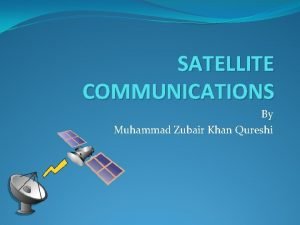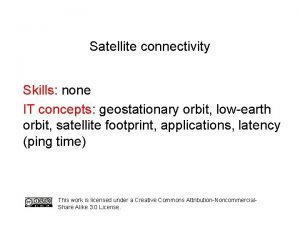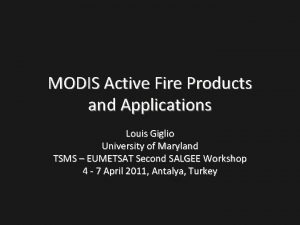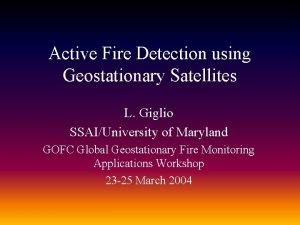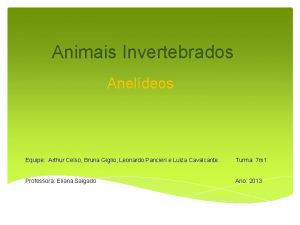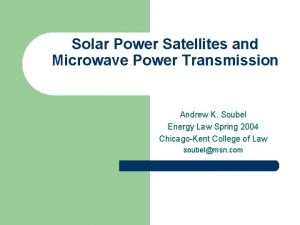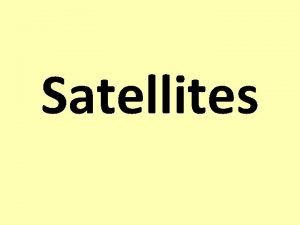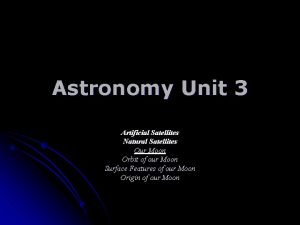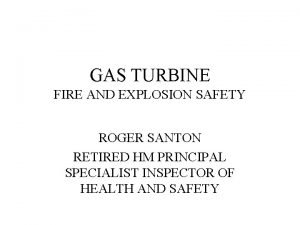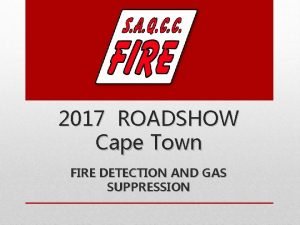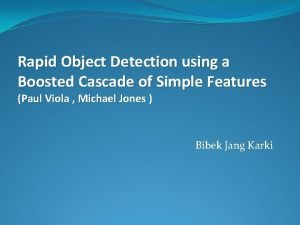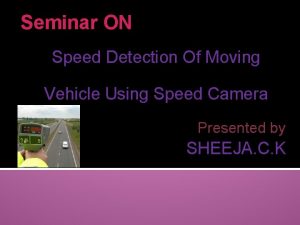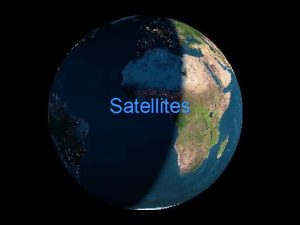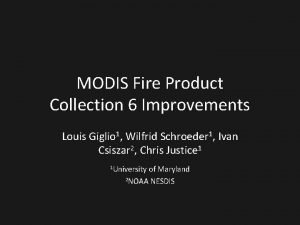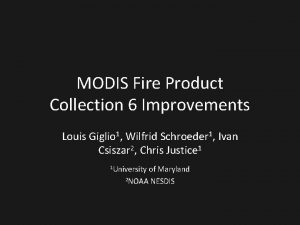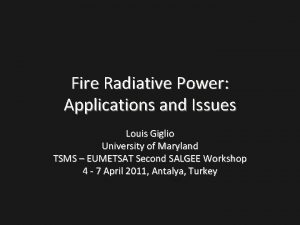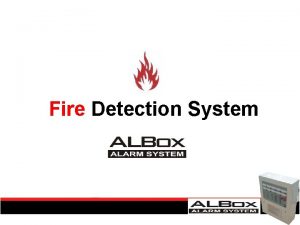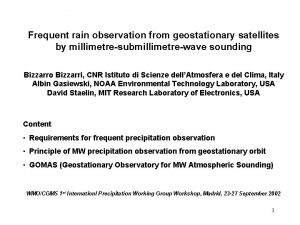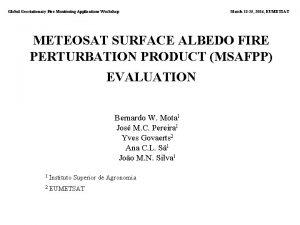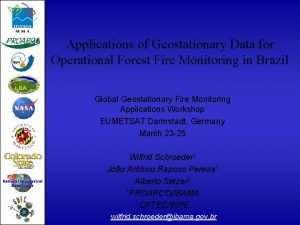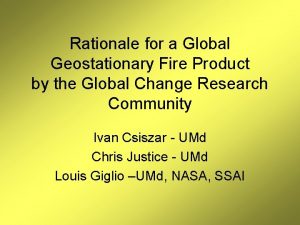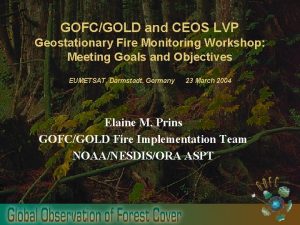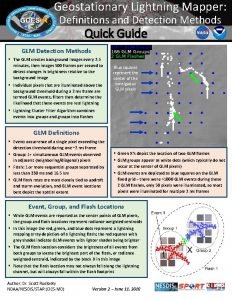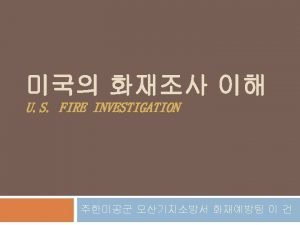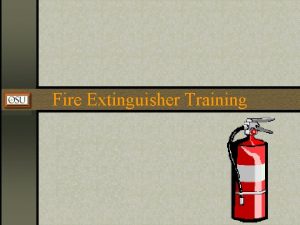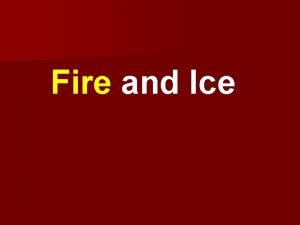Active Fire Detection using Geostationary Satellites L Giglio
























- Slides: 24

Active Fire Detection using Geostationary Satellites L. Giglio SSAI/University of Maryland GOFC Global Geostationary Fire Monitoring Applications Workshop 23 -25 March 2004

Overview • Satellite-based fire detection algorithms • Generic issues related to multi-satellite fire monitoring • Polar vs. geostationary satellite suite comparison – Issues – Biases

Introduction • Multiple systems currently providing active fire data and new systems are being planned • Different systems offer different capabilities – Different detection capabilities (spatial/temporal) – Different fire monitoring groups using different methods and different algorithms • Accuracy of the different systems not well quantified – Systematic validation activities being initiated • User community is starting to combine data from these multiple systems – complementary data sets

Satellite-Based Fire Detection Algorithms • Virtually all exploit tremendous radiative energy emitted at ≈4 µm, usually in conjunction with a longer wavelength ≈10 µm band – Exception is DMSP-OLS • ABBA/WF-ABBA (Prins et al. ) are the premier detection algorithms for geostationary satellite instruments – GOES VAS, GOES Imager • Detection principals are well-described elsewhere

Geostationary Satellite Suite • GOES-8 – 1995 -2003 • GOES-10 – 1998 onward • GOES-12 – 2003 onward • MSG-1 – 2003 onward • MTSAT – Late 2004

International Global Geostationary Active Fire Monitoring: Geographical Coverage 80 60 -120 GOES-W -80 GOES-E -40 0 40 80 120 MSG 160 MTSAT 40 Satellite View Angle 80° 65° 20 0 -20 -40 -60 -80 322

Multi-Satellite Fire Monitoring: Generic Issues • Systems have – Different spatial resolutions – Different radiometric characteristics – Different temporal sampling • How do we combine observations from multiple instruments in a consistent, meaningful manner?

Polar Fire Monitoring: Strengths and Weaknesses • Strengths – Global coverage • Frequency of global coverage depends on scan width – Higher spatial resolution • Moderate resolution – AVHRR, MODIS (1 km) • High resolution – Landsat, ASTER (30 m) • Weaknesses – Fewer opportunities for cloud-free observations • MODIS Terra/Aqua give four observations per 24 hrs – Greater variance in envelope of detectable fires (off nadir vs. nadir) – Temporal sampling issues related to diurnal fire cycle

Theoretical Detection Envelope • MODIS • Temperate deciduous rainforest • Night • 0° scan angle • Summer • No background fires

Geostationary Fire Monitoring Suite: Strengths and Weaknesses • Current Strengths – Hemispheric fire monitoring – Near-real time data for fire management – Few/no temporal sampling issues related to diurnal fire cycle – Broad Direct Broadcast capability • Current Weaknesses – Gaps in global spatial coverage – Spatial biases in envelope of detectable fires

Potential Gaps in Spatial Coverage

Spatial Biases in Envelope of Detectable Fires (1 of 2) • For instruments on board geostationary satellites, pixel size varies as a function of distance from the sub-satellite point – Introduces spatial gradient in the envelope of detectable fires

Size of footprint relative to footprint size at subsatellite point.




Spatial Biases in Envelope of Detectable Fires (2 of 2) • Complicates comparison of fire activity in different regions, even using a single satellite • Not an issue for near-real time fire monitoring • Will need to be addressed in production of a global data set

High resolution sensors can provide muchneeded fire size distributions. ASTER Scene 2. 4 µm R 1. 6 µm G 0. 5 µm B

Size Distribution of Active Fires

Southern Africa, 2000 Morisette et al. , in press.

GOES Diurnal Cycle Research Issue • How to merge different sampling of diurnal fire cycle? – Temporal sampling exhibits a spatial dependence since local time varies with longitude – What impact does this have on the number of fires detected when combined with the spatial variation in detection envelope?

TRMM VIRS Diurnal Fire Cycle Borneo 1999 -2001

GOES Local Sampling Time: Function of Longitude

Summary • Geostationary satellite suite will provide a major contribution to global fire monitoring capability • Ultimately envision merging both polarorbiting and geostationary fire data sets to exploit strengths of each • Interesting research opportunities in addressing potential issues
 Geosynchronous and geostationary satellite difference
Geosynchronous and geostationary satellite difference Geostationary orbit
Geostationary orbit Geostationary
Geostationary Geostationary
Geostationary Giglio
Giglio Giglio
Giglio Alessandra giglio
Alessandra giglio Giglio
Giglio Bruna giglio
Bruna giglio Bruna giglio
Bruna giglio Makrocytos
Makrocytos Cindy giglio beaumont tx
Cindy giglio beaumont tx Jacopone da todi donne de paradiso
Jacopone da todi donne de paradiso Parti del giglio
Parti del giglio Solar power satellites and microwave power transmission
Solar power satellites and microwave power transmission Use of polar satellite
Use of polar satellite Exhibition for satellites
Exhibition for satellites Blood spatter satellites
Blood spatter satellites Natural satellites
Natural satellites Satellites in orbit around earth continually fall toward
Satellites in orbit around earth continually fall toward Skew and schism
Skew and schism Smoke detection gas turbines
Smoke detection gas turbines Saqcc fire detection training
Saqcc fire detection training Rapid object detection
Rapid object detection Speed detection of moving vehicle using speed cameras ppt
Speed detection of moving vehicle using speed cameras ppt
